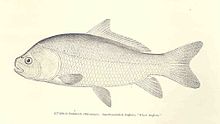Smallmouth buffalo
| Smallmouth buffalo | |
|---|---|

| |
| Scientific classification | |
| Domain: | Eukaryota |
| Kingdom: | Animalia |
| Phylum: | Chordata |
| Class: | Actinopterygii |
| Order: | Cypriniformes |
| Family: | Catostomidae |
| Genus: | Ictiobus |
| Species: | I. bubalus
|
| Binomial name | |
| Ictiobus bubalus (Rafinesque, 1818)
| |

| |
| The distribution of I. bubalus in the United States | |
| Synonyms | |
| |

The smallmouth buffalo (Ictiobus bubalus, from the Greek for "bull-fish" and "buffalo") is one of the longest-lived fishes, capable of living more than a century.
Physical characteristics
The coloration of smallmouth buffalo ranges from shades of gray to brown and coppery green dorsally and pale yellow to white ventrally. Fin colors match the portion of the body where they attach and are generally darker towards the tips. They are characteristically stocky, having a hump that rises up from the
Habitat
The smallmouth buffalo is a hardy fish that frequents clear, moderate to fast-moving streams, but has been occasionally known in some lakes and ponds. If prefers waters with dense aquatic vegetation and a silty bottom. It has a high tolerance for hard water and can survive in waters with pH ranges of 6.5–8.5.
Diet
The smallmouth buffalo's diet is primarily that of a
Life history
Relationship with humans
Although historically and derogatorily considered by many to be a rough fish, smallmouth buffalo are native to North American ecosystems, are the most common commercially sold freshwater fish in the United States, are sought after by traditional anglers on rod-and-line,[8][2] and they have rapidly become sportfish as modernized night bowfishing has become increasingly popular since 2010 - a sport that targets this species among others.[6][9][10] Management of this species is in urgent need of reassessment as essentially no agency is tracking the ecological impact of modernized bowfishing, and there are virtually no limits on harvest. The species is highly valued by some as a human food source and the fish meal is common in animal feed. They are relatively quick and easy to raise in commercial farm ponds. Anglers seeking to hook a smallmouth buffalo have found success with doughballs and corn on hooks.[2]
An 82 lb 3 oz (37.3 kg) fish taken from Athens Lake, Texas on May 6, 1993 by angler Randy Collins stands as the International Game Fish Association (IGFA) all-tackle world record for the species, while a 63 cm (2.07 ft) specimen caught on May 16, 2022 in
References
- . Retrieved 20 November 2021.
- ^ PMID 37864074.
- ^ S2CID 199636657.
- ^ a b c Snow, Richard (2020). "Examination of the Current Oklahoma State Record Smallmouth Buffalo". Proceedings of the Oklahoma Academy of Science. 100: 16–21.
- ^ ISSN 0275-5947.
- ^ PMID 31149641.
- ISSN 1095-8649.
- ^ "Fishing for Buffalo". University of Minnesota Press. Retrieved 2020-06-14.
- ISSN 0022-8443.
- ISSN 0275-5947.
- ^ "Buffalo, smallmouth (Ictiobus bubalus)". International Game Fish Association. Retrieved 5 November 2022.
- ^ a b "N.C. Freshwater Fishing State Records". North Carolina Wildlife Resources Commission. Retrieved 5 November 2022.
- ^ a b Venters, Vic (March 1992). "Angler Targets Little Known Species: New Smallmouth Buffalo State Record Caught". Wildlife in North Carolina. N.C. Wildlife Resources Commission. p. 31. Retrieved 5 November 2022.
- ^ "Ohio Boating Accident Data Archive". Dnr.state.oh.us. Retrieved 2017-02-26.
- ^ "Smallmouth Buffalo (Ictiobus bubalus)". Tpwd.state.tx.us. Retrieved 2017-02-26.
- ^ "Smallmouth Buffalo (Ictiobus bubalus) - FactSheet". Nas.er.usgs.gov. Retrieved 2017-02-26.
External links
 Data related to Ictiobus bubalus at Wikispecies
Data related to Ictiobus bubalus at Wikispecies Media related to Ictiobus bubalus at Wikimedia Commons
Media related to Ictiobus bubalus at Wikimedia Commons

